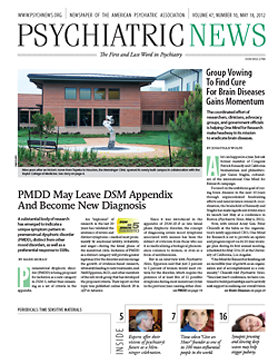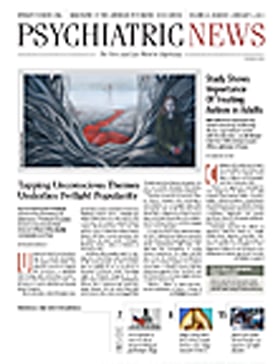Premenstrual dysphoric disorder (PMDD) is being proposed for inclusion as a new category in DSM-5, rather than remaining as a set of criteria in the appendix.
An “explosion” of research in the last 20 years has validated the existence of severe and distinct symptoms—marked most prominently by emotional lability, irritability, and anger—during the luteal phase of the menstrual cycle. Inclusion of PMDD as a distinct category will provide greater legitimacy for the disorder and encourage the growth of evidence-based research, ultimately leading to new treatments, said Neill Epperson, M.D., and other members of the sub-work group that has developed the proposed criteria. Their report on this topic was published online March 28 in AJP in Advance.
Since it was introduced in the appendix of DSM-III-R as late luteal phase dysphoric disorder, the concept of diagnosing severe mood symptoms associated with menses has been the subject of criticism from those who see it as medicalizing a biological phenomenon common to women, or even as a form of antifeminism.
But in an interview with Psychiatric News, Epperson said that just 2 percent to 5 percent of women would meet criteria for the disorder, which require the presence of at least five of 11 possible symptoms during most menstrual cycles in the previous year causing either clinically significant distress or interference with work, school, usual social activities, or relationships with others.
Epperson recalled a patient she had treated for the disorder who returned to see her a year later. “She told me, ‘You changed my life.’ ”
“If you have ever sat down and talked to a woman who has struggled with this disorder most of her reproductive years, you become convinced,” Epperson said. “It’s very clear from the research evidence and from clinical experience that it’s a small minority of women who experience the level of severity required to merit a diagnosis under the proposed criteria. However, the burden of illness can be as great for women with PMDD as for those with major depression.”
Epperson pointed out that actual changes to the criteria that are currently in DSM-IV are modest. More important has been a reordering of symptoms, giving priority to the symptoms of emotional lability, irritability, and anger rather than depressed mood.
“The work group agreed that clinically depressed mood is not the first thing you think of when you think of PMDD,” she said.
Daily Ratings Helped Validate Symptoms
She cited an article that appeared in the March Archives of General Psychiatry reporting daily ratings of perimenstrual symptoms and functioning in two samples—a representative cohort in a general community setting and a self-identified help-seeking cohort in a clinical setting. The ratings validated the symptoms in DSM-IV but found that depressed mood was less frequent than other affective symptoms. The article, by S. Ann Hartlage, Ph.D., Kimberly Yonkers, M.D., and colleagues, is titled “Criteria for Premenstrual Dysphoric Disorder: Secondary Analyses of Relevant Data Sets.”
Epperson added that the new criteria proposed for DSM-5 emphasize that symptoms do not necessarily have to be present during the entire luteal phase of the menstrual cycle or totally resolve as soon as menstruation begins. Also slightly different from the DSM-IV criteria is the inclusion of “clinically significant distress” in criterion B; currently, only interference with usual activities is included in criterion B.
“We felt it was important to emphasize that these symptoms can be associated with distress as well as interference,” she said. “Whether symptoms interfere with a woman’s usual activities can depend on her circumstances and individual factors such as coping strategies and lifestyle. A woman may experience extreme irritability, but if she works and lives alone, she may not have the opportunity to experience interpersonal conflicts. Although she is quite distressed by how she feels, the lack of interference with work and relationships may have kept her from meeting the DSM-IV criteria for PMDD.”
SSRI Treatment May Be Effective
The most salient feature of PMDD, which distinguishes it from other mood disorders, is its uniquely predictable pattern of symptoms: they begin to improve within a few days after onset of menstruation and are minimal, if not absent, in the week postmenses.
Related to the timing of symptoms, and supported by substantial literature that has emerged since publication of DSM-IV in 1994, is the response of patients to treatment with SSRI antidepressants. Epperson said there is now a sizeable body of research demonstrating the effectiveness of luteal-phase treatment with SSRIs, beginning with the onset of symptoms and terminating after menstruation.
That’s a treatment response that is unique to PMDD. “There are many psychiatric disorders for which we use SSRIs, but none that are treated effectively with intermittent therapy,” she said. “That’s extremely important when distinguishing PMDD from other disorders of affect. People with severe PMDD can sometimes look like they have bipolar disorder, but you would never treat someone with bipolar disorder with intermittent SSRI therapy.”
Also demonstrating that PMDD is distinct from other mood disorders are studies indicating the role of ovarian hormones in the pathogenesis of PMDD. And functional MRI, positron emission tomography, and proton magnetic resonance spectroscopy demonstrate specific differences in neural network activation, glucose metabolism, and neurotransmitter concentration between prospectively characterized women with PMDD and healthy comparison subjects.
Epperson emphasized one aspect of the criteria for PMDD that is being carried over from DSM-IV: the importance of daily symptom rating. “Clinicians really need to do prospective daily rating of symptoms across two symptomatic cycles to determine if a patient has PMDD and not a depression that is exacerbated by menstruation,” she said. “This is especially important if a clinician is going to use luteal-phase treatment with antidepressants.
“The benefit of luteal-phase treatment is that you can avoid the side effects that may accompany long-term continuous treatment,” she said. “But it’s important to determine through prospective symptom rating that a patient has PMDD. And luteal phase treatment may also be difficult or impossible if a woman is symptomatic during her entire luteal phase and has very short cycles.”


